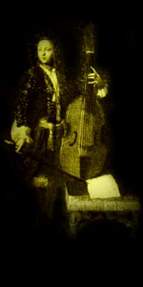 |
 |
 |
 |
 |
|
The viola da gamba, or viol, is a bowed string instrument with frets. It is held upright and supported between the legs. Viola da gamba literally means leg viol. It can also be played, as a plucked instrument, across the lap. Generally, it is a six-stringed instrument, but seven-stringed basses are very popular and five-stringed instruments are not rare.
The viol is made in different sizes. The most popular sizes are treble, tenor and bass. The bass viol pictured here is a Bertrand Style (c.1720, France) made by Charlie Ogle of Eugene, OR. Bass viols are very similar in shape and size to cellos, but the viol family most likely evolved from a desire in the 15th century for bowed instruments resembling the size and tuning of the Spanish guitar. Like the guitar, gambas have flat backs, are very lightly constructed and the tuning sequence is typically in intervals of a 4th, 4th, major 3rd, 4th, 4th. An extra forth is added to the seven stringed bass which is tuned as follows: A-D-G-c-e-a-d. The tone is quiet with a distictive "reedy" quality. The viol is an ideal instrument for playing polyphony.
The viol bow is convex rather than concave like a violin bow. It is commonly called a Baroque bow. Modern bows are held overhand. The viol bow is held underhanded, palm facing upwards. The stick of the bow is held between the thumb and forefinger. Tension is regulated by the player's middle finger directly on the hair.
Viol bowing is opposite to violin bowing in all senses. The bow moves across the string rather than downward with the weight of the arm above the bow. Heavy accents are not possible. Light accents are easily achieved at the start of stoke, with a push (up) bow. Violin technique uses down bows as the start of a stroke. The viol's light construction coupled with the low tension of the strings makes the viol highly resonant and responsive to light bowing. The ability to control the tension of the bow hair with the middle finger creates exquiste sublties of tones and accents. It is a highly effective bowing technique for creating clear, rich textures and well defined notes.
The richness of the instrument is enhanced by the action of the left hand against the frets. The string is stopped hard directly behind the fret. This produces an open string sound. The finger remains in place until it is necessary to move it to another position. This enables the instrument to resonate the string sound past the action of the bow against it. Frets ensure stable intonation and allow great variety of positions for the left hand. This same variety is not possible on unfretted instruments
The viol appeared in Europe near the end of the 15th century. It quickly spread to all corners of the continent and was popular at home as well as at court. It was common in many homes to have a chest of viols. Therein would be found viols of each size. The viol was perfectly suited for consort music, or music for small instrumental ensemble pre c.1700. Consort music was the "popular" music of the era and the viol became one of the most popular instruments during the Renaissance and Baroque periods.
This popularity inspired a remarkable history of viol composers and performers across Europe and into England. Henry the VIII wrote for the instrument and employed a consort of Italian players. England was abundant with remarkable viol composers such as Byrd, Jenkins, and Purcell. The viol remained popular in England long past its fall from glory across the rest of Europe.
France led European viol playing from 1675 to 1770. The long list of French viol composers include Couperin, De Machy, Forqueray, Rousseau, and Rameau. Viol duets and trios that included the violin were popular, but the French favored the bass viol as a solo instrument or accompanied by continuo. The pinnacle of solo viol composition is said to have been achieved by French composers culminating with the works of Marais.
The north German and Flemish viol schools were influenced by the French, but the majority of Germany and the Low Countries were influenced by the English consort style. The viol was used extensively in sacred music of this region. Solo repertoire was not developed in these areas until late in the 17th century. Composers from this region include Bach, Buxtehude, Schenck, Schutz, Telemann, and C. P. E. Bach.
In the late 17th to mid-18th centuries, the popularity of the viol began fade. The cello had been improved so to produce clear tones and higher volumes than the gamba. This made the cello better suited for the louder 18th century ensemble style.
At the end of the 19th century, the viola da gamba reappeared. Researchers became interested in the music of earlier centuries. The pioneer of 20th century viol playing was Arnold Dolmetsch. His daughter, Natalie, founded the Viola da Gamba Society (England, 1948.) In 1963, the Viola da Gamba Society of America was founded. Since the 1970s, the interest in the viol has found its way throughout the world. Twentieth century composers such as Bulent, Fricker, Loeb and Maxwell Davies are creating new works featuring the viola da gamba.
©1998 K.Constant
|
| LINKS |  |
|
|
|
|

